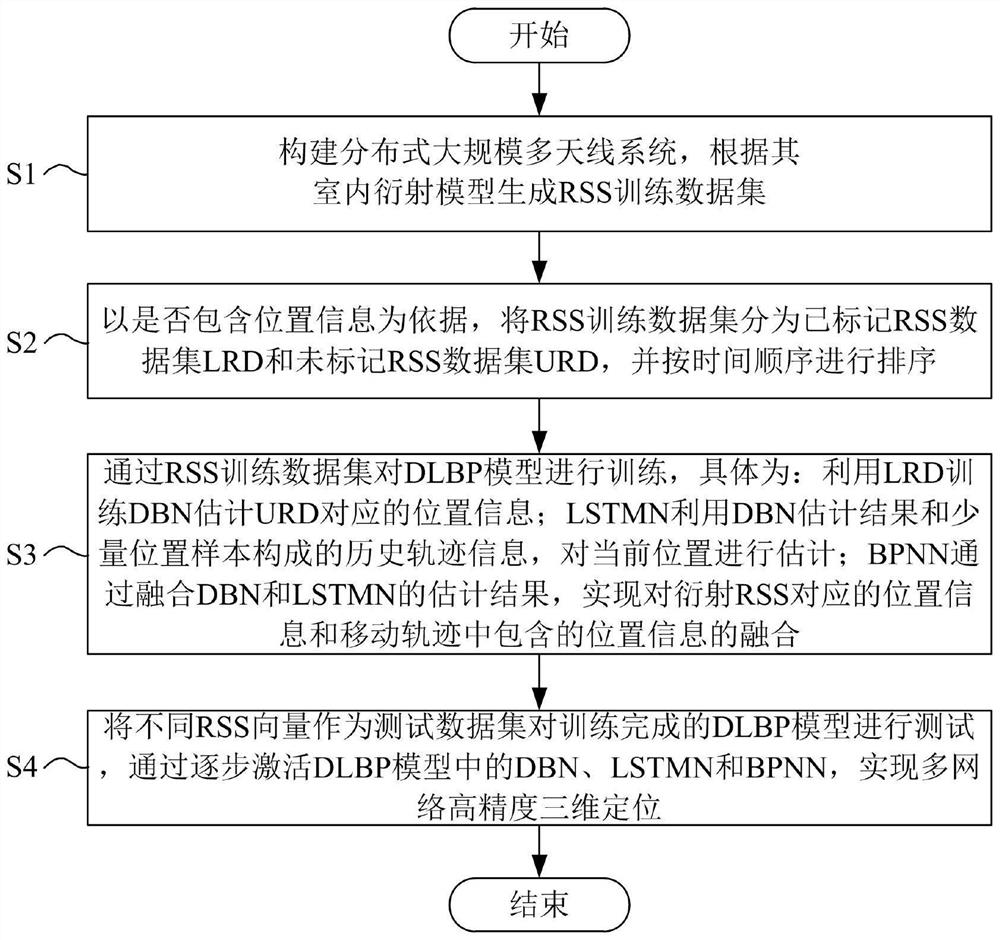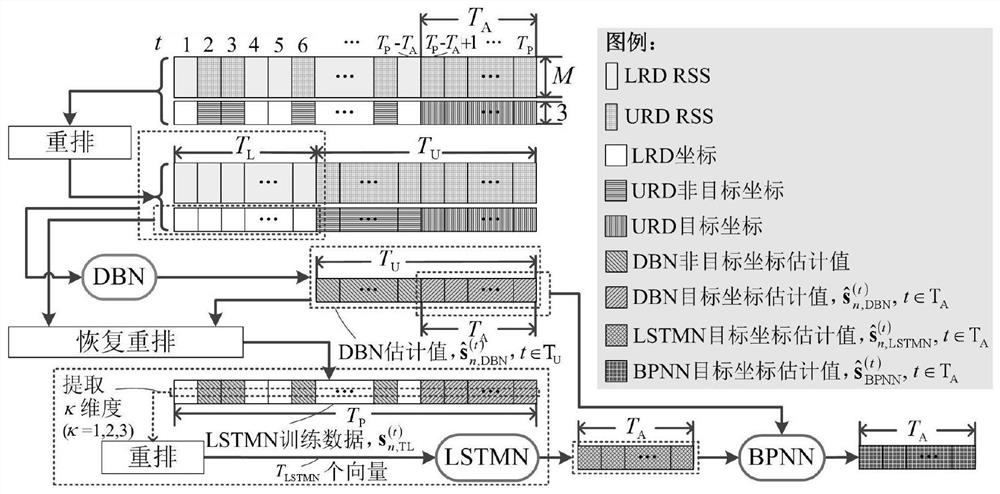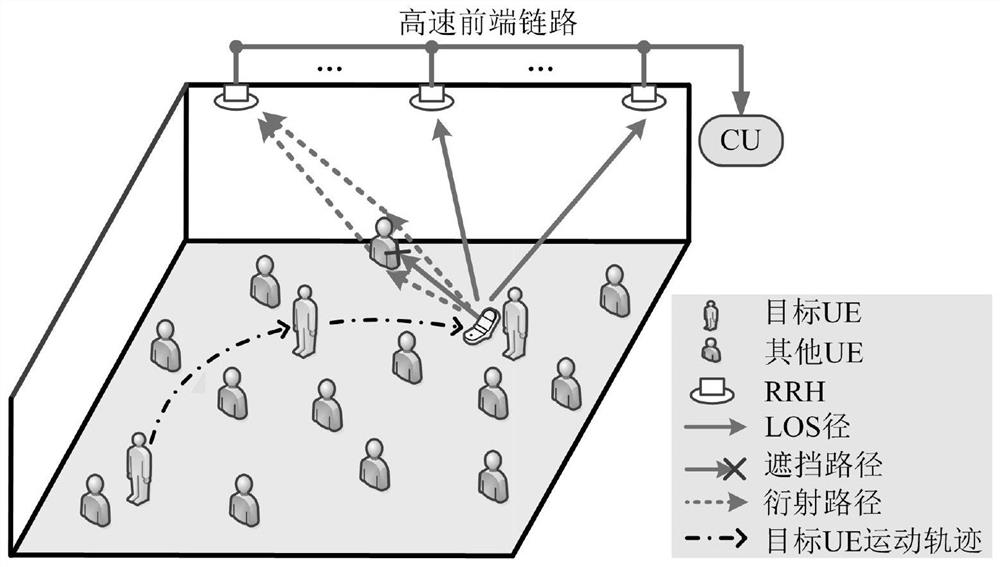A multi-network assisted positioning method for distributed large-scale multi-antenna systems
A multi-antenna system, assisted positioning technology, applied in the field of positioning, machine learning, and wireless communication, can solve the problems of deviation of positioning results from accurate values, high data measurement costs, unfavorable practical applications, etc., to improve adaptability, high positioning accuracy, cost reduction effect
- Summary
- Abstract
- Description
- Claims
- Application Information
AI Technical Summary
Problems solved by technology
Method used
Image
Examples
Embodiment 1
[0036] The invention relates to the fields of wireless communication, positioning and machine learning, and includes multiple-input multiple-output (Multiple-Input Multiple-Output, MIMO) technology, a positioning technology based on received signal strength (Received Signal Strength, RSS), and a deep belief neural network (Deep Belief Networks). , DBN), Long-ShortTerm Memory Networks (LSTMN), Back Propagation Neural Networks (BPNN), etc. More specifically, it relates to a multi-network assisted positioning method for distributed large-scale multi-antenna systems, such as figure 1 shown, including the following steps:
[0037] S1: Build a distributed large-scale multi-antenna system, and generate an RSS training dataset based on its indoor diffraction model;
[0038] S2: Based on whether the location information is included, the RSS training data set is divided into a labeled RSS data set LRD and an unlabeled RSS data set URD, and sorted in chronological order;
[0039] S3: T...
Embodiment 2
[0049] (1) Generation process of RSS training data based on diffraction model
[0050] On the basis of Embodiment 1, the indoor positioning scene is as follows image 3 As shown, for ease of presentation, in step S1 of this solution, the same term "UE" is used to represent the device and the person using the device. There are M RRHs and N UEs in a DM-MIMO system, and each RRH or UE has one antenna. The UE moves on a random route and sends pilot signals to all RRHs. The system proposed in this scheme rationally arranges the pilot frequencies of each UE, and adopts mechanisms such as time division multiplexing to keep the pilot frequencies orthogonal to each other, so as to eliminate multi-user interference. Without loss of generality, assume that in the time domain, each UE transmits T P time-domain pilots are used for training, and the time interval between two consecutive pilots of the same UE is t 0 . It is worth noting that if image 3 As shown, due to the dynamic top...
Embodiment 3
[0178] More specifically, in order to further verify the beneficial effects of this scheme, such as Figure 8 As shown, taking the number of RRHs M=20 as an example, a schematic diagram of two different antenna distributions is given, and this solution shows the performance of the DLBP method under the conditions of different antenna distributions. Unless otherwise stated, the main simulation parameters are listed in Table 1, where M and p L The value of may vary depending on the applicable simulation scenario. Meanwhile, traditional DBN-based Positioning (DBNP) and BPNN-based Positioning (BPNN-based Positioning, BPNNP) methods are used as comparison methods.
[0179] Table 1 Simulation parameter table
[0180]
[0181]
[0182] Figure 9 The localization performance under different numbers of RRHs is shown, where the proportion of LRDs in all training data is set to p L = 0.6. It can be observed that the DLBP method proposed in this scheme achieves the lowest RMSE am...
PUM
 Login to View More
Login to View More Abstract
Description
Claims
Application Information
 Login to View More
Login to View More - R&D
- Intellectual Property
- Life Sciences
- Materials
- Tech Scout
- Unparalleled Data Quality
- Higher Quality Content
- 60% Fewer Hallucinations
Browse by: Latest US Patents, China's latest patents, Technical Efficacy Thesaurus, Application Domain, Technology Topic, Popular Technical Reports.
© 2025 PatSnap. All rights reserved.Legal|Privacy policy|Modern Slavery Act Transparency Statement|Sitemap|About US| Contact US: help@patsnap.com



